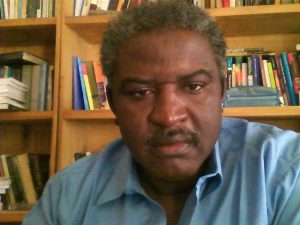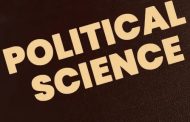This is the second piece from Prof Ibrahim Bello-Kano of Bayero University, Kano to Intervention this week. The first came under the title The Relevance of the Conceptual Or Theoretical Framework in Modern Literary Studies. This is on a much weightier topic than that one. It is considered a good stuff for a weekend. It has, therefore, neither been edited nor being serialised. Enjoy the stuff:

The author, a Prof of English and Literary Studies at Bayero University, Kano
By Ibrahim Bello-Kano
To dissimulate is to pretend not to have what one has. To simulate is to feign to what one doesn’t have. One implies a presence, the other as absence
—Jean Baudrillard. (“The Procession of Simulacra” Ed. R. J. Lane. Global Literary Theory. Routledge, 2013, p. 217).
Laughter is an effect resulting from the sudden transformation of a heightened expectation into nothing
— Immanuel Kant. Critique of Judgement. Cambridge: 2002, p. 209.
Introduction
Since the publication of Karl Jasper’s classic book, The Idea of the University where he argues, among other things, that “The university is a community of scholars and students engaged in the task of seeking truth” (Boston: Beacon Press, 1959: 1), scholars such as J. F. Wyatt (1982), Michael Oaskeshott (1989), Jurgen Habermas and John R. Blazek (1987), Alasdair MacIntye, Jacques Derrida (2001), and Ronald Barnett and Michael Adrian Pets, (2018) have put theoretical, philosophical, and sociological pressure on its efficacy as an accurate or plausible or realistic description of the philosophical foundation of the modern university. All of them are agreed that Jasper’s definition or description of the university has to be qualified is so many ways that very little of his core argument still stands today. Barnett and Blazek, and the contributors to their three-volume work, reached very critical conclusions about the current state of the universities, from Europe and America to Asia and Africa.
Meanwhile, let us note that all institutions produce signs of all sorts— advertisements, “talk-about-talk” (discourse), neon-lights, effigies, radio sounds, designs, logos, and language of all kinds, Google, Toyota, car companies, TV show— in short, these are what may be called signifiers of presence, authority, legitimacy, justification, identity, “mission and vision”, self articulation, (as found in the logos, emblems, insignia, and symbols of such institutions). The reason for all this will be explored below.
The university is part of this very process of emblematic self-identification, with its logos, emblematic discourses, academic, administrative signifiers (Professor, Lecturer, Vice Chancellor DVC, etc), signboards, sign-posts, and its principal signifiers of “knowledge”, “knowledge production”, the disciplines, the institutes, the research centres, mosques, churches, faculties, libraries, books, monographs, essay and students, and nomenclatures such as Council, Chancellor, Pro-Chancellor, Registrar, Dean, HOD, Director, Registrar— all these make the university a “Treasure-house of Signs”. These “signs” are treasured and values and are the basis of much normative academic values and self-affirmation, self-assuredness, and self-justification.
The Idea of the University and Knowledge Production
The word, for example, is a “sign”. Thus the sign “university”, or indeed the very idea of the university, emerged with the advent of Modernity or modern society and social organization of normativity and what we may call “knowledge-production” within “the reality concept of the open context” based on models and concepts that do not need any justification from the past, and whose models of knowledge is one of incomplete result of the realization, what Hans Blumenback describes as a “dependability constituting itself successively, as never definitive and absolutely granted consistency” (The Legitimacy of the Modern Age. MIT Press, 1993, p. 32). The so-called ancient university in the Middle East, the Mediterranean, and some parts of Europe and West Africa such as the University of Oxford, Al-Azhar in Cairo, and the University of Sankore, Timbuktu, in modern Mali were not properly and programmatically universities in the modern sense of the word, but theological seminaries devoted to the study of divinity or theology and the study of Grammar and Rhetoric. It was only in the 18th century or thereabouts the modern universities emerged in Europe and America, for example, with the establishment of the universities of Harvard, Gottingen, Jena, the University of Paris, and those in Essex, Sussex, Bradford, Leicester in the UK, universities that are far younger than the universities of Ibadan, Khartoum, and Legon.
Those universities were based on the idea of the intellectual division of labour and the segregation of teaching and research based on disciplinary models and labels of the Natural Sciences, the Social Sciences, and the Humanities (Studio Humanitatis). In the early modern period of the university idea, medicine was concerned with sanitation, care and cure, healing and the Nominalist idea the doctors should seek to disenchant nature in order to know its inner workings or hidden structures so as to find the basis of cure and healing, and in some cases, the prevention of disease and infection. Today, we have many doctors and scientists who are devoutly religious and who see care or healing, despite their reliance on, and application of modern bio-technology and pharmaceuticals, and medical procedures as part of the transcendent and the transcendental. Yet even in the very or the most modern universities, not much new knowledge is produced in the technical, technological, scientific, and social and humanistic knowledge. Although one sees new books being churned out by the major international and local publishers and book circuits, it is still the huge corporations that produce cutting-edge knowledge, corporations and technology and car and communication and cultural capital companies such as Toyota, Tesla, BMW, Siemens Apple, Google, Ali Baba, and a host of relatively smaller but rich and endowed companies that produce new or exploit the well-known circuits of old knowledge, the treasure-house of knowledge production. These knowledge-producing companies design the new technologies of the modern world, namely airplanes, jets, computers, Artificial Intelligence, Robotics, cars, bullet trains, new-fangled bridges and bridge designs, nuclear stations, roads, and sophisticated weapons of warfare and crowd control. Take, for example, the Covid-19 vaccine, its production is wholly dominated by a few companies from Astra-Zeneca, and Johnson and Johnson to Moderna. The Astra-Zeneca vaccine had the name “Oxford” because of the data run in which the university participated. Patent laws forced A-Z to include the name “Oxford” on the first trials of the vaccine.
In information technology, the big names are Google, Apple and their subsidiaries. Thus from one area of knowledge-production to another, it is the corporations and the richest companies in nano-technology, biotech, genetics, space exploration (the US NASA, the Hines Academy of Science, the European Space Agency) that dominate in the area of research in engineering, technology, pharmacology and pharmaceuticals, and other high end research areas.

Some of the most regarded universities in the world today
In these areas of cutting-edge research, then, the universities are no match for the big corporations, but may here and there contribute research assistants or the most versatile professors. Take the example of the Massachusetts Institute of Technology (MIT): it is heavily funded by the corporations and high heeled technology companies such as Tesla, and the big banks such as the Lehman Brothers.
The picture is slightly different in the social and management sciences and the humanities. Here, original research is possible, but only based on the training, innovation, and inventiveness of the researcher. But even here, too, research and teaching are based on well-laid out models, some of them going back to some 50-100 years ago. Indeed all that these disciplines do these days is repeating, re-dressing, re-cycling, and de-deifying well-known models of knowledge in their respective areas. Nor much that is refreshingly new knowledge is produced by academics in these areas, beyond some sensational or eye-catching innovative adaptation of those models here and there.
Thus the intellectual cultures of the university are either only iterations of well-known models or the application of established knowledge to cure sick people in general, quarrels over the appropriate conceptual frameworks, or trial and error based on known mathematical and technological models.
In the Nigerian context, the universities fare no better. I think the Government has sensed this Why is that? It is because in Nigeria, university education is a fashion statement, a route to social and economic progress, if not a potential for it. Among the youth, it is also cool and what all young men and women want to do. In the universities, the lecturers give lectures to the students. The latter pretend to take down “notes”. When it is time for class tests, the assignment or examination, the students migrate en mass to online searches for the relevant information. Students openly plagiarize online academic materials and pass them off as their own hard, independent research. Some of the lecturer staff members are in relatively the same situation: most don’t buy personal books or have a personal study, or even browse the library. Some Professors never bother to read new information in their declared research field or interest. Only the very few among our colleagues keep their head above the stagnant academic pool.
University Office-Seeking Mentality and the Clique Culture
The university atmosphere in virtually all Nigerian campuses is now heavy with the air of officialdom, office-seeking, and clique groups. The culture of office-taking is threatening to take over the academic and research endeavours of colleagues. The growing bureaucracy and bureaucratization of university life— reach centres each with a Director, more DVCs, more mundane committees to do small jobs, the rush to build the so called symbols of progress (office edifices) rather than more lecture halls and student hostels, etc. is a virtual new re-description of the idea of the university.
Thus the university as we know it is now slowly becoming an mere Emblem of Narcissism, or is, at least, emblematic of the spectral, the luminous, the fashionable, and the recycling and re-duplication of economic and ideological space. The increasing encroachment of the “civil service mentality” (the mentality not of service but of emblematic perquisites), the quiet re-description of the university authorities as “the management”, the introduction of perks for the higher officials, official cars, wardrobe allowance, etc. has given a personal competitive motive and incentive for professors to want to get to the top positions at all costs, and sometimes not bother to be or remain scholars and academically productive people in their respective academic research fields. In campus after campus, academics are falling over themselves to be the Vice chancellor, or other well-heeled positions in the university system and outside it.
Crisis in Teaching and Research Output
Many a university-based journal has dwindled to arenas for stale research or re-duplication of research topics. Online academic discussion, called webinars, zoon academic sessions are now the order of the day. Classroom teaching has fared no better. It is recycling all the way. The students themselves are cynical at best and largely trust mostly online sources rather than the lecturer’s course materials or only follow out the lecture to its conclusions for fear of failing the exam. Indeed the universities have become, to all intents and purposes, the conveyor belt of all sorts of academic copy. It is also true that training sessions, both formal and informal, are increasingly being brought about from the outside via Google, online seminars, webinars, zoom sessions, YouTube, WhatsApp, Telegraph, and new academic technologies via the Web are now slowly becoming the new centres of knowledge production. Now with these rising developments, the intellectual need not be based in the university. Indeed a kind of non-academic public intellectual culture is slowly forming elsewhere and in cyberspace.

Our own UI
Signs Taken for Wonders
Much of the literature on the university usually identifies it by description or by its alleged function, as Karl Jaspers does when he describes the university thus, quoted above: “The university is a community of scholars and students engaged in the task of seeking truth” (p.1). The problem with this “definition” of the university is that it identifies it with its supposed functionality, by what it does but not by its “name”. Let us take the word “university” as a “sign”. As sign the word “university” is not a natural or organically pre-existing concept or name but is culturally constructed. The sign is not a “link” between a name (university) and a thing called BUK or ABU or UI. It is, rather composed of concept (signified, the object, the thing called BUK, ABU, UNILAG) and a sound pattern (signifier— the expression “u-n-i-v-e-r-s-i-t-y”).
In the light of the above formulation, there is no reason why the signifier “university” should be connected with the concept of being a space of knowledge of knowledge (production), teaching, and learning. Rather, it is just a space for a purpose other than being a space of academic knowledge production but something that is socially and culturally constructed. The signifier “university” is a usage that society as a whole has agreed to conventionally call it so. Thus the signifier “university” does not universally refer to a collection of buildings with a gate, a road network, a fence, car parks, and with a Vice Chancellor, lecturers and students.
In this case the sign “university” does not unite a thing (a collection of buildings with a gate, a road network, a fence, car parks, and with a Vice Chancellor, lecturers and students), with a name “Bayero University Kano”(for example) but a concept and a sound image. The “sound image” does not denote a purely physical thing but the psychological mark or imprint of the sound and the impression it makes on our senses and the cultural imprint it “stamps” on our normative understanding of what that word or expression implies for us within the cultural formation.
Now one implication of the preceding discussion is that a thing (say BUK or ABU or UI) or a name designated by the signifier “university” may not be a university but simply the effect of our sensual, cognitive identification of it as such or what we think it is. Indeed it is collective behaviour, based on convention that imputes the sign or the signifier to a particular name or place. This is how and where language and ideology come together. Linguistic usage, in this case the yoking of a sign (the word “university”) to a signifier (Bayero University, Kano) is what gets us social users of a language to link a name to a thing. Thus, by implication, this is how ideology and politics work in this specific sense: we or the language we use, or the conventions that society has established “pulls the wool over our eyes” and leads us to naturalize the links between a signifier and a signified. The implication is that it is our way of avoiding the arbitrary links between a name and a physical space that gets us to forcefully, psychologically and consciously identify a name with a particular thing.
In other words, we just assume BUK is a university on the basis of linguistic usage and an ideological investment in the name and the physical space. Many would find it counter-intuitive and a sort of linguistic violence and a threat to their identity and the space occupiers of a physical entity for it to be denied the name “university”. In this case, BUK is not a university (because there is no organic link between the signifier “university” and a supposed signified called Bayero University, Kano). That BUK may be drastically and qualitatively something else than a university, but this is something we would not or would never accept as “reality”. Perhaps BUK is just something other than a university, it is, perhaps, an academic cinema, a TV show, a job centre, a cultural-ideological laboratory, a hierarchical process of differentiation between strata, a pond in which its users routinely dip their dry clothes, a theatre of conflict or envy or even a fashion show arena, complete with a cat walk paraphernalia, etc.
Now this does not mean that an individual has the freedom and the choice to call BUK a TV station or a cinema. This is because the signifier “university” and the signified, supposedly the place called Bayero University, Kano, are now firmly established in the way we use language, in the way ideology and politics (emotional identification with the place, and our invested interest in the designation of BUK as a university) confirms our sense of superiority over, say, a college of education, our justification for collecting a university-based salaries, our self-description as lecturers, professors, vice chancellors, or as members of ASUU would be thrown into crisis). So, in this case, the Sign (with its bifurcation into the signifier and a signified) produces in our linguistic and psychological identity visual signifiers namely signals, bill boards, name plates that tell us “this is a university and it is BUK” and that assure us that this is indeed the case, and nothing else. Although there is no natural connection between the signifier and the signifier in this case under discussion, ideology and cultural-professional identity enforces and seeks to “naturalize” (in our psychology and political and economic and institutional interests) that connection link.
The University as a Simulacrum
In the cultural, ideological and, probably, linguistic history of human beings, there is always a distinction between truth and falsehood, inside and outside, legitimacy and illegitimacy. The point is that is any physical university, say BUK, an original realization of “The Idea of the University” or only a mere approximation to it? Is BUK, for example, the bearer of the original “The Idea of the University” or only a copy of it in a specific context? As we humans engage in social communication, in linguistic social exchange, we may imagine social constructions such as our university arena as a brute physical space. So, we go about, or the Administration of the place goes about, making it so “vigorously rich” and detailed in the form of buildings, roads, general infrastructure and designations in the hierarchy of the staff members (Chancellor, Pro-chancellor, Vice Chancellor, Deputy Vice Chancellors, Registrar, Bursar, Librarian, Graduate Assistants, Assistant Lecturers, Lecturers I and II, Readers, Professors, Deans, Heads of Department, Students, etc). The intuitive idea at the university level is to make sure that that particular university achieves the original “The Idea of the University”. Indeed that particular university’s aspiration is to exceed the Idea as to displace it as the very original of the Idea. Yet it is this very aspiration of a university to achieve the distinction of the very realization of the “Idea of the University” that displaces the Idea itself and becomes neither the Original nor the Copy of the Idea.
Notice how ASUU and the other university unions tell the ruling Government to “fund” the universities, to “revitalize” the universities, to pay higher salaries to the staff members, and to take “The Idea of the University” seriously in all instances. Paradigmatically and causally, this leads to the probably conscious worry on the part of the unions and their members that their universities are not retaining, or living up to, the original “Idea of the University”, that they are sliding into a copy of The Idea or that they may miss the opportunity to retain the original Idea. In other words, they do not want to be only a pale copy of The Idea.
Drawing on Jean Baudrillard’s critical theory, we could say that the Original “Idea” has to disappear, or has to be pretended as having disappeared or has to be kept out if the copy of the copy were to, or is to, claim legitimacy. On this view, the university is a copy of a copy because the original “Idea” is no longer tenable or available. Yet it has to function somewhat in the discourses of the unions and their members, for without it, the Government, for example, cannot be held to its responsibilities towards the universities (funding, rejuvenation, revitalization, higher salaries, EAA payments, etc.).
Now we may call all these demands and union psychology a kind of “simulation”. In the unconscious of the unions and their members, the original “Idea” is only a simulated reference. In this case, the Original Idea is only, for these purposes, a “virtual reality”, a kind of “hyperreal”, a surrogate for the Original “Idea”. To quote Baudrillard, this simulation of the Original Idea displaces the latter and erects in its place the hyperreal. The actual real Original Idea starts to decay, or, according to Baudrillard, it is “murdered… It becomes and acquires a ‘performative’ structure, especially if it works and is operational” (p. 218). The simulation of the Original “Idea” is a performative structure for university unions in their encounter with the funding agency, the Government; it works for unions to insist on this or that demand on the Government; it is operational because union members can be mobilized for a strike or a fight with the Government or even with internal university officials. In these instances the unions have no option but to resort to simulation, whose result is the production of the “hyperreal” namely better, rejuvenated, revitalized, better paid and better funded universities. That is why university unions have no need to distinguish between reality and simulations because if they were to do so in the concrete they would have to correlate all the realizations or simulations of “The Idea of the University” across the whole world, which cannot be done because the university system is not a global flat land or an undifferentiated space. Hence, the unions have to refer to the “hyperreal”, the displaced copy, or version, of the original, classical “Idea of the University”. In a word, the hyperreal in this case and context stands in for a structure very close to the metaphysical or Platonic Real.

Looking at it from the lens of the UK
One conclusion we could reach about the university, based on the preceding discussion, is that the universities are transfixed by images, those images spawned by simulation, by “fragments” of “The Idea of the University” and those fragments have become or are now no more than, to borrow a phrase from Charles Baudelaire, “ephemeral, fugitive, contingent upon the occasion” (My Heart Laid Bare and Other Prose Writings. London: 1986, p. 37). What results from all these circuits of signifiers and signifieds in the university context is what Baudrillard would call a “weightless system… and uninterrupted circuit without reference or circumference” (p. 218). The simulation that “The Idea of the University” has become in this context is that the simulation (the one the university unions use or deploy or resort to, or the one individual lecturers and the NUC deploy or adapt and enforce) is itself not something with a define referential system but, rather, the “generation by models of a real without origin or reality: a hyperreal” (p. 216). Why is that? It is because the space of simulation, of the simulated Original “Idea of the University” has disappeared; the truth it claims to be essential to university-based knowledge-production now includes the right to tell lies, to inaugurate a discourse of the Post-truth or the Untruth. The Original Idea of the University did, in fact, contain, even if secretly, the space of its opposite and its opposition: the liquidation of the referent, or the referential system that had sought to tie up Truth and The University together as an indissoluble structure. Not any more: the system of signs says “no!” On this score, “The Idea of the University” as a veritable space of truth and the discovery of new knowledge and new meanings now has no option but to lend itself to equivalent systems of simulation, fictionality, and binary thinking (“university”; “non-university”).
The Idea of the University as Pastiche
If the preceding discussion seeks to re-describe the university and slot it into a system of differences, a system of equivalences (the signifier-signified dialectic; the simulated character of justifications for the university; the Utopia of the university as a community of scholars and students engaged in the task of seeking Truth and validating truth-claims), then the university and the Idea of it are now no more than simulacra; for to simulate is to reduce the object of study or discussion to the signs that constitute it. If the modern university’s raison d’être is the seeking or the discovering of Truth or validating truth-claims based on some special programmatic and epistemological procedures, then it has to admit and incorporate “fragments”, collages of all kinds of knowledge— naturalistic, social, cultural, linguistic, literary-critical, semiotic, philosophic, etc. In that case, the university is, without admitting it, vulnerable to the simulated “principle of equivalences” and “the principle of dissimulation”. One word for this is the sign without values, something called “pastiche”. The Pastiche destroys reference because it is the multitudinous and the slippery; it does not allow the resurrection of the Original Idea; it is an operational double multiplied a hundred fold; it the machine for the fragmented, the dispersed and the indeterminate; it is the space of short-circuiting similarities. Such is the figurative and metaphysical space of Difference.
The University, then, has no option but to admit, despite its universal and grand claims, to be a pastiche. Just like simulation, pastiche is a series of assembled fragments, of fragmented fragments, or what Marx and Engels call in The Communist Manifesto “all that is solid melts into air”, or what Marshall Berman calls, “a paradoxical unity, a unity of disunity… a maelstrom of perpetual disintegration and renewal, of struggle and contradiction, of ambiguity and anguish” (Marshall Berman. All That Is Solid Melts Into Air: The Experience of Modernity. New York: Verso, 1993, p. 15).
A pastiche is a copy of a copy, something assembled from fragments, palimpsests, effigies, wreckage, aporias, the ephemeral, fugitive, and the transient. The pastiche is both gloriously useful and gloriously useless. It is just like the Image and the imaginary: it leaves room only for the tropological recurrence of models based on self-referential forms of the collage, patch work, the random and hodgepodge. The modern university is all that: treasured by some and laughed at by others. It is its function and functionality as a pastiche of sorts that, more than the abstract idea of the university, guarantees its values such as academic freedom, unfettered diversity of contents, and the right to say or write anything.
Laughing Matter
One way by which university people and Unions could cope with the new, deconstructing vision of the university is to resort to or adopt, laughter and to laugh it all off. The laughter may be tragic, joyous, sarcastic, derisive, sardonic or dismissive. As Signifier, the University is more “Sound Without Sense”, or rather with a simulated sense, since the real had disappeared or is liquidated by vested interest. Laughter should be our institutional way of crying about our lot, we academic dwellers of the university. Terry Eagleton argues in Humour (2019) that “laughter may be indicative of human progress” and that only an animal which has learnt to carry objects in its hands rather than its mouth can leave the latter free for chuckling and tittering” (Yale UP, p. 7).
In the simulated university, in the circuit of the university as a signifier without a signified, in the university as a Fragment of fragments, of the ephemeral the fugitive, and the contingent, there is no question of the old, dogmatic seriousness, the old positivist, the old regimented cast of mind that sees the university as Necessary and Real, complete with veritable Transcendent Values. Such a rigid, non-dialectical, pre-signifier attitude is bound to suffer a ship wreck and a perpetual wailing after the fact, a potential exhaustion with the hyperreal. Thus in the liquidation of the referential obsessively harboured by the old, classical “idea of the university”, all we should do is to adopt Friedrich Nietzsche’s idea, namely that we lecturers should laugh it all off because we are at the receiving end of the real-real, the pre-hyperreal idea of the university, we live its combustive deficiencies in salaries, in remuneration, in our utter lack professional pride and decorum before the puny Earned Academic Allowances (EAA). We should laugh it all off because we suffer so atrociously on account of our unthinking idea that we are a university. Why not see the university as a cauldron of insipid signifiers of self-deception, self-dissolution, and self-ravishment. As Annie Leclerk advises, “to laugh is to live profoundly” (cited in M. Kundera. The Book of Laughter and Forgetting. London: 1997, p. 79).




























